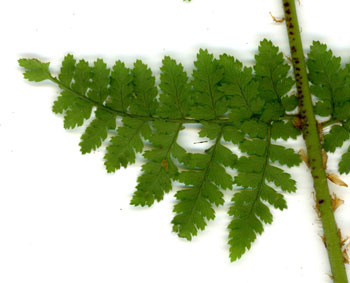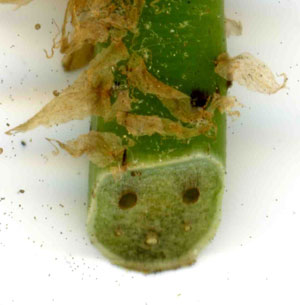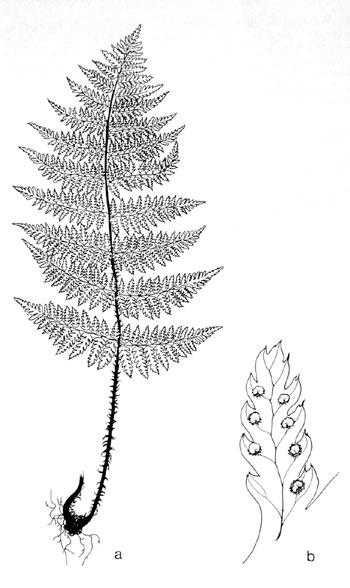| Dryopteris intermedia | ||
Fancy fern, Evergreen wood fern | ||
|
Etymology
Intermedia, presumably intermediate between D. carthusiana and D. campyloptera.
Description
Rhizome: erect, stout.
Frond: 70 cm high by 20 cm wide, evergreen, monomorphic, blade/stipe ratio: 2:1 to 3:1. Stipe: grooved, green, scattered, tan scales, more towards the base, vascular bundles: 5 in an arc. Blade: 3-pinnate at the base, gradually less above, ovate, herbaceous, glandular. Pinnae: 12 to 14 pair, anadromous on the lowest pinna pair, � opposite pinnules above, lanceolate-oblong and more-or-less in plane of blade; lowest pair lanceolate, and not reduced in size; pinnules inner, lower pinnule on the lowest pinna somewhat shorter than the next one; costae grooved above, continuous from rachis to costae; margins serrate, spiny; veins free, forked. Sori: round, in 1 row between midrib and margin, indusium: reniform, at a sinus, sporangia: brown, maturity: midsummer. Culture
Habitat: moist, rich woods, especially in limestone areas.
Distribution: northeastern North America.
Hardy to -35�C, USDA Zone 3.
Distinctive Characteristics
Distinguished from the other spinulose wood ferns by the first lower
pinnules of the lowest pinnae the same length or shorter than the
second pinnule.
Synonyms
Aspidium intermedium Muhlenberg ex Willdenow Dryopteris austriaca (Jacquin) Woynar var. intermedia (Muhlenberg ex Willdenow) C. V. Morton Dryopteris spinulosa (O. F. Mueller) Watt var. intermedia (Muhlenberg ex Willdenow) L. Underwood |
|
|
Notes
Variability A diagnostic character for D. intermedia among the spinulose wood ferns is the shorter first downward-pointing pinnule on the lowest pinna. However, there is great variability, and an anomalous example is easy to find -- see the photo below. On average the character holds.
Variability A diagnostic character for D. intermedia among the spinulose wood ferns is the shorter first downward-pointing pinnule on the lowest pinna. However, there is great variability, and an anomalous example is easy to find -- see the photo below. On average the character holds.

Dryopteris intermedia. Lowest pinna: anadromic, first downward-pointing pinnule longer than the next. This is anonomalous; see the notes. �Scan: Tom Stuart |

Dryopteris intermedia. Glandular hairs just below upper sorus are diagnostic. A hand lens required. There are better examples in the resources. �Scan: Tom Stuart |

Dryopteris intermedia. Vascular bundles at stipe base: five, the two largest visible to the naked eye, the others only through a hand lens. In some cases the smallest bundles disappear before the top of the stipe, leaving only three. �Scan: Tom Stuart |

Dryopteris intermedia. a) frond; b) fertile pinnule, spiny. �Illustration by V. Fulford from Ferns and Fern Allies of Canada, William J. Cody and Donald M. Britton, 1989, � Agriculture Canada, used with permission. |
